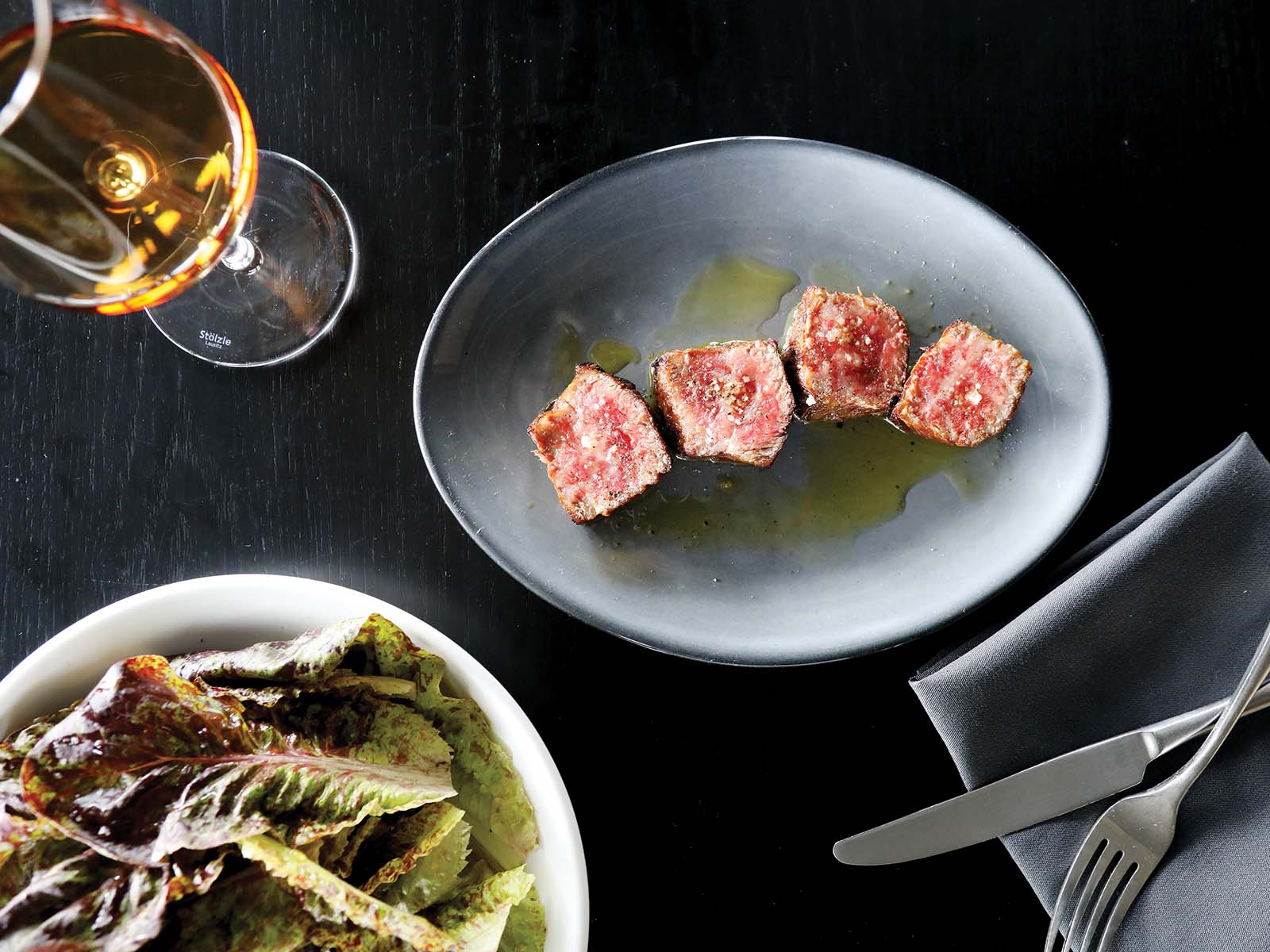The Local newsletter is your free, daily guide to life in Colorado. For locals, by locals.
Corrida
3.5 Stars
- The Draw:
- Refined service; fine aged steaks; carefully executed tapas
- The Drawback:
- High prices; ho-hum design in the dining room
- Don’t Miss:
- Shrimp toast, wagyu carpaccio, crudo, dry-aged tomahawk steak, rare sherries by the glass
My dukes were up as I rode the elevator to Corrida’s rooftop location in the PearlWest building in downtown Boulder. I’d previewed the menu online—$115 for steak is a triggering event for someone of Scottish Presbyterian ancestry like myself. I fear I looked pessimistic upon arrival; the greeter in the lobby probably texted ahead about Mr. Grumpypants being on the way. My dukes were soon down, however. Over two dinners and a tapas-and-cocktails session ($800 in all), Corrida proceeded to charm, delight, and, in every way but one, impress me.
For Boulder, Corrida signals a new era. The city is lousy with startup money but affects a casualness that inhibits restaurants at the high end. The exception, of course, is Frasca Food and Wine, the Friulian sanctuary on Pearl Street. It’s clear that the Corrida team—Bryan Dayton of Acorn, Brider, and Oak at Fourteenth and former Old Major chef Amos Watts—has set its gun sights directly on that James Beard Award winner: on its exactitude with food, wine, and service and on its expense-account hegemony.

The theme is Spanish, spanning a menu of tapas, a compact list of very fancy, very expensive steaks, and a collection of well-chosen Spanish wines, vermouths, and sherries. The proposition is curatorial care amid ceremonial presentation. Gin-tonics are served from a tableside cart. Meat selections involve pensive discussion of the sort you might have when buying a minor Picasso. When the beef arrives, you expect to hear fanfare horns. Bartenders execute proper Basque flourish when cascading tart Isastegi cider from two feet above the glass. I don’t mean that Corrida is fussy; rather, such show befits the ambition of the place.
When Watts innovates, it’s to accent, not dominate, a dish. Thus, the appearance of fried amaranth leaves on a tapas of grilled Jimmy Nardello peppers. Charred and served with cherry tomatoes, crumbly Spanish cheese, and a spicy chile sauce, the peppers were the main point, but the leaves—bitter, crunchy, still hot from the oil—were a surprise. On another tapas plate, pickled mustard seeds popped like chimes in the mouth, brightening the almost lascivious texture of wagyu carpaccio. Watts also took exquisite care with the state of the shrimp on a little pintxo called “tostada de gambas” (shrimp toast); the seafood, sweet and fresh, was perched atop tart piquillo peppers and a disc of fried bread.

Watts is careful to work within the bounds of Basque and Spanish styles, but he’s not averse to adding on-trend touches like cucamelons—which look like grape-size watermelons and taste like fruity cucumbers—to a dramatic bowl of raw tuna, pickled ramps, and “salmorejo,” a bread-thickened tomato sauce. The fish and vegetables formed a dam across their shallow bowl, holding the sauce to one side. In Spain, tapas are often assembled in a slapdash fashion; at Corrida, a fair amount of tweezering and careful spooning is in evidence. Still, nothing teeters into preciousness.
Despite such precision, some dishes fell just short of splendid. A classic “pan con tomate”—grated fresh tomato and garlic on grilled bread—nailed the bright flavor, but the bread lacked the slightly soaked, comforting texture found in the best versions in Spain (and it came with a bowl of aïoli, a jarring afterthought). Patatas bravas did not have the crunchy-creamy comfort of the ideal. Several of the gin-tonics were good but lacked the concentration of flavors you find in Barcelona’s most serious gin temples.
These are quibbles, however, especially when you consider the beef. Over two dinners, I invested in two steaks: an Angus tomahawk rib-eye from Carter Country Meats in Wyoming and an American wagyu strip loin from Colorado’s 7X Cattle Company. Now, meat arcana have crept onto steak menus partly to justify Goldman Sachs pricing but also to give guidance about the flavor and texture you can expect. Corrida’s menu told us that the Angus in the case that evening came from a four-year-old animal that was dry-aged for 45 days, costing $75 per pound. The strip loin was from a 30-month-old animal and aged for 21 days, costing that whopping $115 for 14 boneless ounces.
There was much discussion with the server about how done the tomahawk steak should be. Medium rare-plus? Or just medium rare? My wife likes things less blue, so we settled on the former. It arrived, however, almost rare at the edges and decidedly rare inside. No matter, the meat was so delicious—charred, funky from dry-aging, fatty, juicy, beefy, tender and chewy all at once—that no complaints were made. The strip loin was equally good, if slightly more tender.
Corrida also offers imported Japanese wagyu of nearly the highest grade available. It ranges from $45 an ounce for eye of rib-eye to $55 for spinalis, the ultra-rich rib-eye cap. That would mean paying as much as $440 for an eight-ounce steak of the stuff, but that’s an insane quantity as this grade of wagyu is so shot through with fat, it’s more like foie gras. I find something fetishlike in meat that fatty, and although I’ve tasted plenty of it, it’s not my beef kink. Not for that much jack, and not when Corrida’s two-pound Angus tomahawk arrives with Flinstonian grandeur, already sliced from the bone into ample chunks.

Be aware that even at these prices, you’ll pay extra for fixin’s. The meat is presented lonesome on its platter, like the head of John the Baptist. It comes with a green salad, but you’ll want at least one more substantial side from the tapas menu.
Our tomahawk was matched with a bright, light 2013 red wine from Alicante by Curii Uvas Y Vinos, selected after a pleasant and informed consultation with the sommelier. Corrida’s wine list doesn’t touch Frasca’s for depth or breadth, but it abounds with mid-priced selections ($50 to $90 per bottle) across Spanish regions and flavor profiles.
Corrida’s staff is also helpful with ciders and sherries. Should you be celebrating your brilliance with, say, Netflix and Amazon stock this season, try a $35 glass of Osborne Capuchino 1790 VORS Palo Cortado sherry, a lovely way to explore the rewards of the solera method, in which bits of wine are transferred from barrel to barrel over generations, gaining character; the Capuchino traces its solera DNA to 1790 and has a bitter, caramel, faintly fruity richness that goes on forever.
Earlier, I mentioned that Corrida failed to impress in one way: the decor. There’s a moment as you round the corner after your elevator ride to the roof when you feel like you may be heading to a parking garage. It’s a relief, then, to find the restaurant entrance, beyond which you expect some drama, luxury, and splendor. But despite a few flourishes—neon that snakes about the ceiling, glassed-in meat and wine displays, tufted room dividers—Corrida’s ambience is rather boring. It’s not so much modernist spare as blandly spare, like a midmarket Marriott dining room. This puzzled me but did not, in the end, much diminish the experience—not with food this good, wine this good, and service this good. Simply put, Corrida is worth the splurge.









